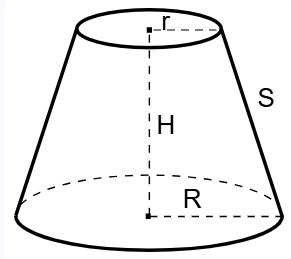1. What is a Frustum of a Cone Calculator?
Definition: This calculator computes the slant height () and the total surface area of a conical frustum, given the height (), base radius (), and top radius (). A conical frustum is the portion of a cone between two parallel planes cutting through it, with a larger circular base and a smaller circular top.
Purpose: It aids in geometry education, engineering, and design by providing measurements for frustum-shaped objects, such as buckets, lampshades, or architectural elements.
2. How Does the Calculator Work?
The calculator uses the following formulas:
- Slant height : .
- Lateral surface area : .
- Top area : .
- Bottom area : .
- Total surface area : .
Unit Conversions:
- Length Units: m, cm (1 m = 100 cm), mm (1 m = 1000 mm), in (1 m = 39.3701 in), ft (1 m = 3.28084 ft), yd (1 m = 1.09361 yd).
- Area Units: m², cm² (1 m² = 10000 cm²), mm² (1 m² = 1000000 mm²), in² (1 m² = 1550.0031 in²), ft² (1 m² = 10.7639 ft²), yd² (1 m² = 1.19599 yd²).
Steps:
- Input the height , base radius , and top radius , selecting their units.
- Validate inputs: and must be positive; must be non-negative; .
- Convert inputs to meters for calculations.
- Compute the slant height and surface area using the formulas above.
- Convert outputs to the selected units.
- Format outputs to 4 decimal places or scientific notation for small values.
3. Importance of Frustum Calculations
Calculating the properties of a conical frustum is crucial for:
- Geometry Education: Understanding three-dimensional shapes and their properties.
- Engineering and Design: Designing frustum-shaped objects, such as containers, architectural domes, or machine components.
- Manufacturing: Determining material requirements for frustum-shaped structures.
4. Using the Calculator
Examples:
- Example 1: Height , Base radius , Top radius
- Convert: , , .
- Slant height: .
- Lateral surface area: .
- Top area: .
- Bottom area: .
- Surface area: .
- Example 2: Height , Base radius , Top radius
- Slant height: .
- Lateral surface area: .
- Top area: .
- Bottom area: .
- Surface area: .
5. Frequently Asked Questions (FAQ)
Q: What is a conical frustum?
A: A conical frustum is the portion of a cone between two parallel planes, resulting in a shape with a larger circular base (radius ) and a smaller circular top (radius ).
Q: Why is the slant height important?
A: The slant height is critical for calculating the lateral surface area, which represents the curved surface connecting the top and bottom circles.
Q: Can the top radius be zero?
A: Yes, if , the frustum becomes a full cone with the top collapsing to a point (the apex). The calculator supports this case.
 Home
Home
 Back
Back
